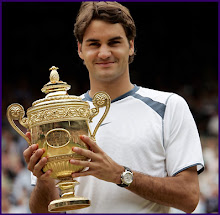How the Serb hits one of the nastiest kickers in the game.
By Paul Annacone
Photos by Manuela Davies/Double Exposure
| 1 For many club players, the toss is the biggest challenge on a kick serve. It must be to your left (if you are righthanded, like Djokovic) and slightly farther back than it is on a flat serve, so you can brush up on the ball to create topspin. Djokovic extends his tossing arm fully, keeps his eyes on the ball, and relaxes his knees. I also like his grip, a bevel turn to the left of the Continental so it’s easier to impart spin (for more on grips, go to TENNIS.com/grips). Another note: Djokovic’s hitting arm lags behind his tossing arm. I wouldn’t recommend this technique for beginners. Club players will have more success if they bring their hitting and tossing arms up together. It takes impeccable timing to let the hitting arm lag behind the tossing arm, as Djokovic does here. You're better off bringing up both arms together. |
| 2 It’s easy to see why Djokovic generates such spin and pace on his kick serve: He’s almost elastic in his wind-up. He coils so much that his back partially faces the net. Djokovic’s racquet and hitting arm both point upward, but notice the angle of his shoulders, which slope downward. His hitting arm is lower than his tossing arm, leaving room for him to extend up to the ball and rotate fully, increasing the speed of his racquet along the way. Djokovic’s knee bend is now deeper and his feet no longer rest flat on the court. |
| 3 Here Djokovic begins to accelerate up to the ball. He drops his racquet head, straightens his knees, and starts to uncoil. Club players can learn a lot about balance and timing from this photo. As Djokovic pushes off with his feet, his shoulders begin to open, but not too quickly—he doesn’t fall into the court. Notice that his tossing arm comes down; otherwise, it would block him from rotating his shoulders. Djokovic's chest points up toward the ball as he drops his racquet and begins to uncoil. |
| 4 Like all great servers, Djokovic drops his racquet to the point where the top of the frame points at the ground (you can see it just below his left arm). His hitting elbow points up as the ball comes into view, slightly in front of him and to the left of his hitting shoulder. His feet are off the ground and his energy is directed up and forward, which will allow him to brush up the back of the ball and propel it into the court with pace. If Djokovic were to let this ball drop, it would brush the side of his head. This is where the ball needs to be for the up-and-out motion required for a kick serve. |
| 5 When you hit a kick serve, your racquet must brush up and over the ball from the 8 o’clock position to the 2 o’clock position (for lefties, it’s 4 o’clock to 10 o’clock). This photo shows Djokovic right after contact, and you can trace the upward arc of his swing path. His hitting shoulder and arm, which started out low in the second picture, are now fully extended, and his shoulders have rotated almost 180 degrees. |
| 6 Djokovic’s momentum carries him well inside the court. His back leg extends outward for balance, while his chest is parallel to the ground. The the most important thing to learn from this sequence is that hitting a kick serve doesn’t just require brushing up on the ball. You must hit out, too. That’s what makes Djokovic’s kicker one of the best in the game. Djokovic's back leg kicks out for balance as he lands on his left foot. |


No comments:
Post a Comment